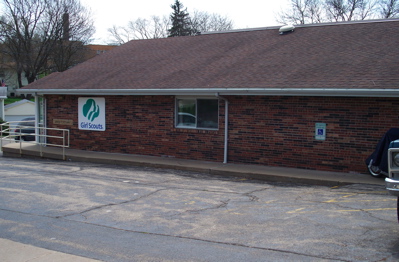Encyclopedia Dubuque
"Encyclopedia Dubuque is the online authority for all things Dubuque, written by the people who know the city best.”
Marshall Cohen—researcher and producer, CNN
Affiliated with the Local History Network of the State Historical Society of Iowa, and the Iowa Museum Association.
GIRL SCOUTS
Being researched
GIRL SCOUTS. The claim to being the first Girl Scout Troop in Dubuque is in question. On April 13, 1924 the TELEGRAPH HERALD displayed a picture in the front page showing what was claimed to be the members of the first troop. Organized by Miss Maybelle Weitz, the troop included Miss Anita Wiedner, chairman; Miss Dolores Graas, secretary; Miss Geraldine Hoop, treasurer; and Mrs. Blunt--the advisor. Members included Neva Skemp, Myrtle Edison, Gertrude Widemeyer, Edith Meyer, Margaret Tonnerson, Maybelle Weitz, Mabel Schara, Virginia Bauer, Isabelle Smith, Leola Klein, Marion Brown, Marion Shaw, Marie Ernest, and Amanda Rafoth.
On November 24, 1942, a second article in the Telegraph Herald identified another troop as the first in Dubuque. Girl Scout Troop Number One in Dubuque, according to this article, began in September 1932. Annette Christianson (a public school teacher), had been a Girl Scout leader in Milwaukee, Wisconsin. She was assisted by Hedwig Salzmann, and Myrtle Faldorf in organizing girls from ST. JOHN'S LUTHERAN CHURCH beginning with Margaret Salzmann, Hedwig Salzmann's daughter.Troop I, the "Lone Troop," registered with national Girl Scout headquarters in 1933, had Christianson as the captain and Faldorf as first lieutenant. A second troop was soon formed.
By 1935 with nine other troops developed in other parts of the city, a council was organized to coordinate and direct the work of the ten troops. A Girl Scout Leaders Club was organized and by 1952 had begun planning work sessions on the weekends at CAMP LITTLE CLOUD. (1)
By 1940 the Girl Scouts were using Camp Burton for a variety of activities including constructing and using a reflector oven. (2) Spreading news of the Girl Scout program was a focus of "Girl Scouting Begin at Seven," a short news reel shown at local theaters during Girl Scout Week in 1938. (3) Girl Scout Leaders Coffee Hours implemented around 1948. featured Mrs. Kenneth Gordon, leader of Troop 47 at WESTMINSTER PRESBYTERIAN CHURCH described the swimming, wood craft, nature study with the benefits to the girls' general health and development of self-confidence. Newcomers to scouting were encouraged to attend one of two training sessions held on Monday and Thursday evenings for three weeks. (4) Five Dubuque Girl Scouts attended a Clinton meeting of the Girl Scout senior area planning board in Clinton in 1950. The topic of discussion was the senior conference for freshmen and sophomore Girl Scouts to be held in Dubuque in the spring of 1951. (5)
Dubuque Girl Scouts, chartered by Girls Scouts of the U.S.A. in 1935, became the Little Cloud Girl Scout Council in 1966.
On May 7, 1985, Hedwig and Margaret were honored at the annual council dinner during the 50-year anniversary celebrations.
In 2013 Girl Scouts nationally was faced with daunting problems. The national membership stood at 2.2 million, down from more than 2.8 in 2003. Donations to the national office and local councils had fallen fro $148 million in 2007 to $104 million in 2011. Perhaps the largest change was a realignment nationally which slashed the number of local councils from 312 to 112 in tge years 2006 to 2009. While intended to increase efficiency, the reduction has resulted in longtime employees and volunteers leaving the program. The mergers affected the Girl Scouts national pension plan. A lawsuit filed claimed that 1850 employees had been added to the pension fund who had never contributed to it. The suit contended that while the pension plan had a surplus over $150 million in 2007, it now had a deficit of $347 million. Financial stress led councils in many states to consider selling off the camps. Iowa was one of the states which attacked the sell-off plans. Some people believed that camping had always been a part of scouting. Others believed camping should be replaced with programs to boost girls' competency with money matters and aid them in pursuing careers in science and technology. (6)
The future of Camp Little Cloud and the Girls Scouts was made even brighter by the donation of the HAMMER, David L. and Audrey Lowe HAMMER estate of $3.8 million. Both were longtime supporters of the Girl Scout movement in Dubuque. Plans announced called for using part of the money for renovations at the camp including construction of cabins capable of handling from twelve to fourteen girls--the size of an average troop. (2)
---
See: Margaret DEMING
See: CAMP LITTLE CLOUD
Source:
1. "Sally Scout Says..." Telegraph Herald, October 9, 1952, p. 21
2. "Dubuque Girl Scouts Enjoy First Week of Outdoor Life at Camp Burton," Telegraph-Herald, June 23, 1940, p. 10
3. "Girl Scouts Review Film," Telegraph-Herald, October 30, 1938, p. 35
4. "Mrs. Delbert Hayford Hostess at Scout Leaders Coffee Hour," Telegraph-Herald, January 29, 1948, p. 15
5. "5 Dubuque Girl Scouts to Attend Clinton Meeting," Telegraph-Herald, November 11, 1950, p. 18
6. Crary, David, "Dissension, Fiscal Woes Beset Girl Scouting," Telegraph Herald, June 24, 2013, p. 20
2. Reese, Kayli, "Girl Scout Council Announces $3.8 Million Donation," Telegraph Herald, May 30, 2023, p. 23


